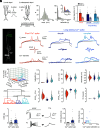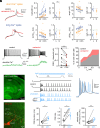Cholinergic regulation of dendritic Ca2+ spikes controls firing mode of hippocampal CA3 pyramidal neurons
- PMID: 39503887
- PMCID: PMC11572977
- DOI: 10.1073/pnas.2321501121
Cholinergic regulation of dendritic Ca2+ spikes controls firing mode of hippocampal CA3 pyramidal neurons
Abstract
Active dendritic integrative mechanisms such as regenerative dendritic spikes enrich the information processing abilities of neurons and fundamentally contribute to behaviorally relevant computations. Dendritic Ca2+ spikes are generally thought to produce plateau-like dendritic depolarization and somatic complex spike burst (CSB) firing, which can initiate rapid changes in spatial coding properties of hippocampal pyramidal cells (PCs). However, here we reveal that a morpho-topographically distinguishable subpopulation of rat and mouse hippocampal CA3PCs exhibits compound apical dendritic Ca2+ spikes with unusually short duration that do not support the firing of sustained CSBs. These Ca2+ spikes are mediated by L-type Ca2+ channels and their time course is restricted by A- and M-type K+ channels. Cholinergic activation powerfully converts short Ca2+ spikes to long-duration forms, and facilitates and prolongs CSB firing. We propose that cholinergic neuromodulation controls the ability of a CA3PC subtype to generate sustained plateau potentials, providing a state-dependent dendritic mechanism for memory encoding and retrieval.
Keywords: CA3 pyramidal neurons; cholinergic regulation; dendritic Ca2+ spike; hippocampus.
Conflict of interest statement
Competing interests statement:The authors declare no competing interest.
Figures




Similar articles
-
Diverse synaptic and dendritic mechanisms of complex spike burst generation in hippocampal CA3 pyramidal cells.Nat Commun. 2019 Apr 23;10(1):1859. doi: 10.1038/s41467-019-09767-w. Nat Commun. 2019. PMID: 31015414 Free PMC article.
-
Distinct dendritic Ca2+ spike forms produce opposing input-output transformations in rat CA3 pyramidal cells.Elife. 2021 Nov 24;10:e74493. doi: 10.7554/eLife.74493. Elife. 2021. PMID: 34817378 Free PMC article.
-
Dendritic voltage-gated ion channels regulate the action potential firing mode of hippocampal CA1 pyramidal neurons.J Neurophysiol. 1999 Oct;82(4):1895-901. doi: 10.1152/jn.1999.82.4.1895. J Neurophysiol. 1999. PMID: 10515978
-
Active dendrites support efficient initiation of dendritic spikes in hippocampal CA3 pyramidal neurons.Nat Neurosci. 2012 Mar 4;15(4):600-6. doi: 10.1038/nn.3060. Nat Neurosci. 2012. PMID: 22388958 Free PMC article.
-
The decade of the dendritic NMDA spike.J Neurosci Res. 2010 Nov 1;88(14):2991-3001. doi: 10.1002/jnr.22444. J Neurosci Res. 2010. PMID: 20544831 Free PMC article. Review.
References
-
- Major G., Polsky A., Denk W., Schiller J., Tank D. W., Spatiotemporally graded NMDA spike/plateau potentials in basal dendrites of neocortical pyramidal neurons. J. Neurophysiol. 99, 2584–2601 (2008). - PubMed
MeSH terms
Substances
Grants and funding
LinkOut - more resources
Full Text Sources
Molecular Biology Databases
Miscellaneous

